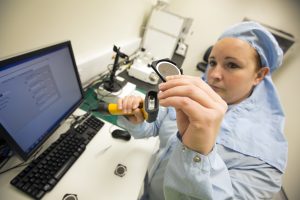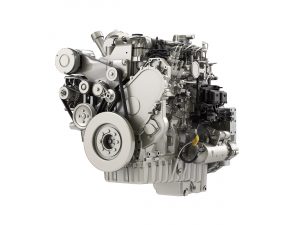Engineering the future
Engineering the future 1 2
 THE TROUBLE WITH BATTERIES
THE TROUBLE WITH BATTERIES
In fact, diesels are naturally lower in CO2 emissions than petrol engines, and around ten years ago people started buying more diesel cars for precisely that reason. Tax levels were low. They also had better fuel economy. Then the Volkswagen scandal happened. Now, the option that is perceived as the most green is the electric car, or the hybrid (a car that has both an electric motor and an internal combustion engine).
This is an area of particular interest for Colin Garner, and one which he feels is also being misrepresented in some of the media. ‘In the press recently, people have been saying that diesel car sales have “plummeted”, and that sales of electric vehicles have “rocketed”. Well, sales of pure electric vehicles have risen from about 0.38% of the total cars sold to September 2016 to about 0.54% to September 2017, while diesel cars have dropped from 47.6% to 42.8% market share over the same period. In absolute terms, I would question whether sales have really “plummeted” or “rocketed”, but that sells newspapers.’
“Even battery electric cars are not completely emissions free”
And how is the electricity that goes into your electric car generated in the first place? According to statistics from Energy UK, in the UK around 25% is generated by renewable sources – wind, wave, marine, hydro, biomass and solar, and another 21% is from nuclear power stations. Much of the UK’s electrical energy, however, is still created by fossil fuels such as gas. So, while electric power may seem clean at the point of use, its production cycle may not be as free of undesirable emissions as we might wish. And, as it turns out, the point of use isn’t without its issues, either. ‘Even battery electric cars are not completely emissions free,’ says Colin. ‘The particulates that come off the tyres are not insignificant. London Underground trains are completely electric, but if you look in the tunnels there’s a black dust, which is brake dust and wear from the wheels etc., combined with ordinary dust from passengers.’
Before you start thinking that Colin is anti-electric, be assured that he is not. He is, however, passionate about the correct data being used – and when one looks at this, problems emerge with the vision of the all-electric future which are rarely discussed in the mainstream media. ‘For example, virtually all the articles I read about batteries say: “Battery technology is improving at a tremendous rate.” And you can put a big tick against that and say: “I totally agree.” But then you look at the absolute numbers and even if you use the really aggressive targets that we hope we’ll reach by the year 2035, batteries alone are still not viable for many applications. It is very application dependent. It’s not one size fits all.’
So, we know electric cars work, but what about the kinds of off-highway applications for which Perkins engines are generally used? Will we ever see completely electric tractors and excavators? The physics of this is challenging.
A good example of the problem faced is demonstrated by the prototype Cummins electric truck. Launched in August 2017, this is a fully battery electric heavy-duty vehicle which boasts the largest battery of any mobile application – bigger than a Tesla. That battery has an energy storage capacity equivalent to about nine gallons of fuel in a diesel truck, which equates to an effective range of around 100 miles. So, a bold development, to be sure – and we’re certain to see improvements to that range in future – but it’s unlikely to be seen doing long hauls along the A1M just yet. Perkins don’t make engines for on-highway trucks such as this, but if anything the demands on their engines are even greater.
For Colin, one of the real issues with electric vehicles is how long they take to refuel, and the availability of that fuel. ‘There’s a unit called “miles per hour” which is how many miles you can travel in an electric vehicle per hour of charge. Most cars, if they’re plugged into a domestic 13A socket might get 30 miles of range per hour of charge. If you have one of these fast chargers in your house you might get two or three times that. If you go for one of the superchargers you may get something like 200 miles per hour of charge. Now, most diesel cars have a range of about 600 miles. If I fill up my car with diesel fuel, it takes about three minutes. If I include the time queuing up to pay for it – and buying my car magazine – let’s say about six minutes. Six minutes is a tenth of an hour, so my charging rate for that vehicle is 6,000 miles an hour.’
Of course, most people, most of the time, don’t need a 600 mile range. ‘With electric cars, people compromise – and if you have off-road parking and can charge it up overnight, and you only use it for commuting, it’s fine.’ Switch that scenario to off-highway applications, at a site perhaps in the middle of nowhere, and where machine downtime is money lost, and it is very different. If you need it to be fast-fill and free of a charging point, then, to use Colin’s words: ‘it’s really hard to displace an internal combustion engine.’
He believes the future will not be as radically different as some propose, but will see us using lots of different solutions for different applications, rather than having one great global panacea. He also sees no reason why the internal combustion engine – demonised though it often is – should not be a big part of that. ‘Internal combustion engines are sometimes called “conventional” engines, as if they are boring and not very high tech. In fact they are very advanced, with amazing attributes in terms of cost, performance and durability. There are off-highway machines that will have 10,000-15,000 hour operation at high load factors and still be very clean in terms of their emissions.’
What it comes down to, perhaps, is not so much the perception of the engine itself, but of the fuel. Fossil fuels – from which petrol and diesel derive – are almost universally regarded as ‘bad’, they are dirty. They release the CO2 that nature has safely locked away for millennia. And they are a finite resource. It stands to reason that we need alternatives – if not now, then some time soon.
 ALTERNATIVE FUELS
ALTERNATIVE FUELS
What comes as a surprise to many is that internal combustion engines are incredibly adaptable when it comes to their fuel source. ‘There are lots of alternatives out there,’ says Colin. ‘Internal combustion engines are not tied to crude oil.’
So what are the viable options?
Plant-based biofuel is one possibility – not only renewable, but with one other major environmental advantage, as Duncan explains: ‘There are various hydrocarbon-based fuels that can be part of what is known as a virtuous cycle. So, theoretically it is possible to plant crops, convert them to a liquid fuel, burn it in an engine and through that repeating process create a virtuous cycle: absorbing CO2 in the growing of your crop, and then releasing it in the burning of the fuel, to be absorbed by the plants again.’
Colin Garner has some significant caveats to add to that, however. ‘Biofuels might win on carbon dioxide, but are not necessarily cleaner in other respects. In terms of NOx emissions and smoke, some biofuels could be worse.’ He has his own favourite for the fuel of the future: GTL, or ‘gas to liquid’. It can be used in a diesel engine – it’s virtually a drop-in fuel – and there is roughly twice as much natural gas in the world, in energy terms, as there is crude oil. At the moment the price is higher, but that could change. We don’t have to run what we call diesel engines on diesel. That means we have fast-fill, the ability to turn it into motive power highly effectively, and many available scenarios in future. For heavy duty, off highway engines it is going to be pretty hard to beat energy dense liquid fuel.
One fuel that is currently being investigated by Exxon Mobil, among others, is an algae-based biofuel, grown in water. ‘Again, that is part of a virtuous cycle because in growing the algae they absorb CO2,’ says Duncan. ‘These algae biofuels are a “live fuel” – which means they are heavily oxygenated – i.e. there’s a lot of oxygen within the molecules that you are burning, so you get a cleaner burn. According to current research, burning these fuels more than halves the engine-out particulate. So, it is a virtuous cycle fuel, because it’s absorbing CO2 when it’s being made and is improving in local air quality as well.’
With all such alternatives, however, it comes down to economics – whether they can be made at the right price point. ‘The answer right now is probably not,’ says Colin Garner. ‘But if the crude oil price goes up, then alternatives become more viable.’ He believes we will continue to use diesel for some time. ‘You get more energy from diesel than petrol on a volume basis – literally more bang for your buck. We currently have at least a 50-70 years reserve production ratio. It’s safe and easy to store and is readily available, so it’s a very good fuel from that point of view – and now cleaner than many other fuels.’
But what of ‘peak oil’? Aren’t fossil fuels a finite resource? ‘The oil reserve is not a fixed value. The reserve is based on three things: you’ve got to know the oil is there; it’s got to be extractable using proven techniques, and it has got to be economic to do it. So, if you drill a hole and find some oil, there’s more reserve. But also, if you come up with a new technique of extracting it, you also have more reserve. And if the price goes up, more places become viable, and so the reserve goes up. Many oil wells, when they get to just, say, 25% full, they become uneconomic, so they leave what’s left. But if the price goes up, it becomes more economic to extract what’s left. So, it’s not a fixed thing. Yes, it is a finite resource – but there is still an awful lot out there.’
In other words, the fuel might go away, but the internal combustion engine probably won’t. And it is largely through the efforts of manufacturers such as Perkins – rarely reported though they may be – that these are now clean enough to serve our future needs.
Engineering the future 1 2















